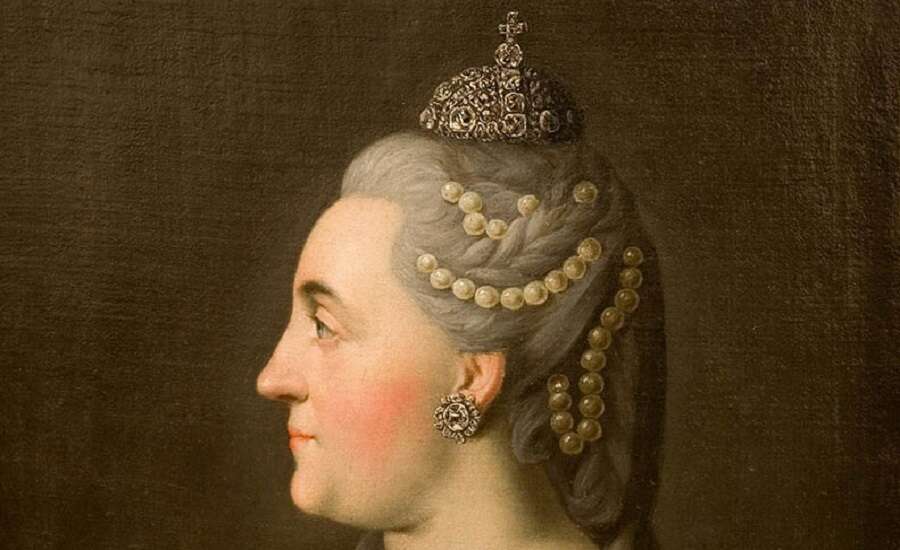
Portrait of Empress Catherine the Great by Antropov
Empress of Russia (1762-96). Born Sophie Friederike Auguste von Anhalt-Zerbst, on May 2, 1729, in Stettin, Prussia (now Szczecin, Poland). At the age of 16, she married Grand Duke Peter of Holstein, the grandson of Peter the Great and the heir to the Russian throne (later Peter III). Their marriage was an unhappy one, and Catherine (now baptized into the Russian Orthodox Church under that name) spent much of her time preparing for her future reign and engaging in extramarital affairs.
Supported by the Russian military, Catherine overthrew Peter III in 1762. Eight days later, Peter III was assassinated and Catherine was proclaimed empress of Russia under the title Catherine II. During her 34-year reign, Catherine carried out an energetic foreign policy. She extended the Russian Empire to the Black Sea as a result of two successful wars against Turkey (which lasted from 1768-1774 and from 1787-1792), while also bringing about the three partitions of Poland.
Despite pretensions to enlightened ideas, Catherine's domestic policies achieved little for the mass of the Russian people, though great cultural advances were made among the nobility. In 1774, she suppressed the popular rebellion led by Yemelyan Pugachev, and later actively persecuted members of the progressive-minded nobility.
Catherine died from an unexpected stroke on November 17, 1796, at the age of 67. She was succeeded by her son Paul.
Catherine the Great’s Court
Catherine the Second assumed power in 1762 after a coup d' etat, which she planned together with the officers of the Emperor's Guard. Unlike her husband, she was loved and respected by the country's elite. She had a very good reputation in Europe thanks to her contacts with many figures of the French Enlightenment - being in correspondence with F. Volter and D. Didro.
Catherine's court was extremely luxurious. She was the first to move into the newly built Winter Palace for domicile. Catherine started an imperial collection of arts which later became the world-famous Hermitage. For the growing royal collections of art Several additional buildings (the Small Hermitage and the Old Hermitage) were built. The Hermitage Theater was constructed nearby and the area around the palace was put in order and complemented with the finest houses and palaces. The most prominent embankments on the left bank of the Neva river were coated in red granite and the marvelous wrought iron fence of the Summer Gardens was built by Yuri Felten in 1773-86.
Under Catherine's patronage science, the arts and trade have flourished.
For the Russian Academy of Sciences a new building was constructed, the Academy of Fine Arts and the first Public Library (now the Russian National Library) got the new architectural complexes. The large Gostinyi Dvor trading complex was opened on Nevsky Prospect in times of Catherine. Many educational institutions were established (including first one for women in 1764 The Institute of Noble damsels of Smolny Monastery).
Catherine considered to be a continuator of Peter's activity and ordered to Falcone a monument with the inscription "Catherine II to Peter I" (a world-famous Bronze Horseman).
In Tsarskoye Selo several additional buildings to the royal palace were built. One of these new wings (the Cameron Gallery) served for Catherine the Great herself. The lovely park surrounding the Tsarskoe Selo palaces still bears the mark of Catherine's times.
Among Catherine's many reforms was the reform of St. Petersburg's local administration. In 1766 the position of "gorodskoi golova" was established and since that time the position of City Mayor appeared in St. Petersburg. In 1774 the Magistrate (Municipal Council) was formed, and in 1786 it was transformed into the City Duma.
A monument to Catherine the Great was built in 1873 in a garden on Nevsky Prospect (between the Public Library established by Catherine and the Alexandrinsky Theatre). She was buried in St. Peter's and Paul's Cathedral where since times of Elizabeth Petrovna all Russian Emperors were being buried.
Join us on Facebook
We invite you to become a fan of our company on Facebook and read Russian news and travel stories. To become a fan, click here.
Join our own Russian Travel, Culture and Literature Club on Facebook. The club was created to be a place for everyone with an interest in Russia to get to know each other and share experiences, stories, pictures and advice. To join our club, please follow this link.